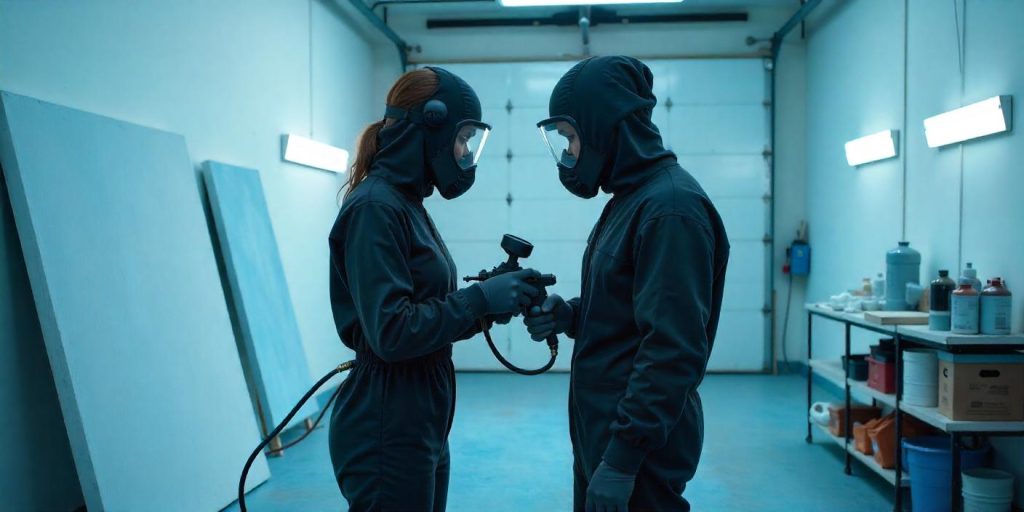Setting up a paint booth in your garage is an excellent way to tackle painting projects while keeping your space clean and your results professional. A dedicated paint booth allows you to manage overspray, dust, and fumes effectively, making it ideal for car parts, furniture, or other DIY projects.

This guide will walk you through the step-by-step process to create a functional and safe paint booth in your garage.
Contents
Why Build a Paint Booth?
Contain Paint Overspray
- Prevent paint from spreading to unwanted areas in your garage.
- Protect nearby items and surfaces.
Improve Air Quality
- Proper ventilation minimizes the buildup of fumes.
- Ensures a safer environment during and after painting.
Achieve Professional Results
- Reduces dust and debris settling on wet paint.
- Provides a controlled environment for even finishes.
Tools and Materials Needed
Tools
- Measuring tape
- Utility knife or scissors
- Staple gun or duct tape
- Box fan or industrial fan
- Masking tape
Materials
- Heavy-duty plastic sheeting or tarps
- PVC pipes or wood for framing
- Furnace filters
- Clamps or zip ties
- Paint-specific respirators
Step-by-Step Guide to Creating a Paint Booth
Step 1: Choose the Right Location
- Select a Well-Ventilated Space
- Your garage should have windows or doors that can be opened for airflow.
- Clear the Area
- Remove items that could be damaged by paint or obstruct your workspace.
- Clean the floor and walls to minimize dust and debris.
Step 2: Measure and Plan the Booth
- Determine the Size
- Ensure the booth is large enough to accommodate your project and allow for easy movement.
- Plan for Airflow
- Position the booth near a window or door for effective ventilation.
Step 3: Build the Frame
- Use PVC Pipes or Wooden Supports
- Create a rectangular frame with enough height to stand comfortably.
- Secure the Frame
- Use clamps, screws, or zip ties to ensure stability.
Step 4: Attach Plastic Sheeting
- Cover the Frame
- Drape heavy-duty plastic sheeting or tarps over the frame.
- Seal the Edges
- Use duct tape or a staple gun to secure the sheeting tightly, preventing gaps.
Step 5: Create Ventilation
- Install a Box Fan
- Position a box fan at one end of the booth to draw out fumes.
- Add Furnace Filters
- Place filters over the fan intake and exhaust areas to capture paint particles.
- Ensure Airflow Direction
- Set up airflow so fresh air enters one side while fumes exit the opposite side.
Step 6: Add Lighting
- Use Bright, Even Lighting
- Install LED lights outside the plastic sheeting to avoid overheating.
- Prevent Shadows
- Ensure lighting reaches all areas of the booth for consistent visibility.
Step 7: Test the Setup
- Check for Stability
- Make sure the frame is sturdy and the plastic is secure.
- Verify Airflow
- Test the ventilation system by turning on the fan and observing the airflow direction.
- Inspect for Leaks
- Walk around the booth to ensure no paint or fumes can escape.
Safety Precautions
Wear Protective Gear
- Always use a respirator rated for paint fumes.
- Wear gloves and protective clothing to avoid skin contact with paint.
Avoid Fire Hazards
- Do not use open flames or sparking tools near the booth.
- Use electrical equipment that is properly insulated.
Maintain Ventilation
- Keep the ventilation system running until the paint is fully cured.
- Periodically replace furnace filters to ensure efficiency.
Benefits of a DIY Paint Booth
Cost-Effective
- Building your own booth is significantly cheaper than renting or buying a professional setup.
Customizable
- Tailor the size and design to fit your specific needs.
Convenient
- Set up and dismantle the booth as needed, keeping your garage functional.
Tips for Using Your Paint Booth
Minimize Dust
- Wet the floor lightly before painting to trap dust particles.
Test the Setup
- Conduct a small test spray to check for airflow and particle control.
Clean Between Projects
- Dispose of used filters and clean the plastic sheeting to maintain a pristine environment.
Common Mistakes and How to Avoid Them
Inadequate Ventilation
- Ensure the fan and filters are powerful enough to manage fumes and overspray.
Unstable Structure
- Use sturdy materials and secure all connections to prevent collapse.
Overlooking Lighting
- Insufficient lighting can lead to uneven paint application.
Alternatives to DIY Paint Booths
Portable Paint Booths
- Purchase pre-made booths that can be set up quickly and easily.
Professional Services
- For large or complex projects, consider hiring a professional painting service.
Conclusion
Creating a paint booth in your garage is a practical and efficient solution for handling painting projects of all sizes. With the right tools, materials, and safety precautions, you can set up a booth that protects your workspace and delivers professional-quality results.
Whether you’re repainting car parts or crafting furniture, a DIY paint booth ensures clean, controlled, and satisfying painting experiences.
